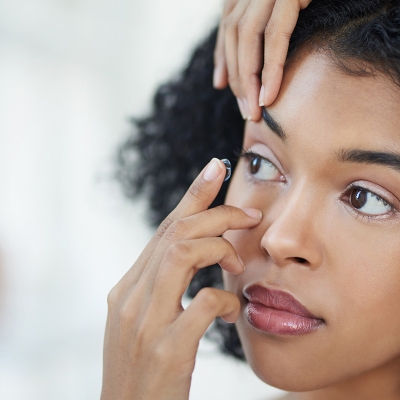Glasses vs. contacts: The eyewear showdown
Here’s how to choose the eyewear that’s right for you.

Life is full of choices. And for many people, one of the toughest is deciding between glasses and contacts. Both eyewear options can improve your vision, but which is right for you? To help you decide, two experts point out some pros, cons, and situations to consider before making a purchase.
You and your eye doctor will decide what’s best for you in the end, but this handy guide can help you weigh your options.
Need new glasses? In 3 easy steps, you could have a new pair on the way. Check your vision coverage, select your favorite frames, then check out. Done!
Your UnitedHealthcare Vision plan
Let’s start with what your plan covers. A UnitedHealthcare Vision plan offers an annual comprehensive eye exam and a choice between a frame allowance or a contact lens benefit.
If you opt for glasses, you have a frame allowance that you can use to buy frames. Popular lens options like UV protection or anti-reflective coating are available to you at price-protected amount. Plus, standard scratch coating and polycarbonate lenses for dependent children are available at no cost. You also can receive a 20% discount on additional pairs of eyeglasses, including prescription sunglasses.
If you’re thinking about contacts, your benefit either includes a formulary that offers full coverage for select brands, or an allowance for whatever brand you choose, or both. You can choose anything from single use to permanent lenses.
You can use your UnitedHealthcare Vision benefits to buy glasses and contacts at your eye doctor’s office or from a local optician. But you can also buy online, and get discounts, at uhcglasses.com (for glasses and contacts).
If you spend your day staring at screens
Glasses can help you avoid the digital eyestrain that many computer users experience. “Contacts stop your eyes from getting oxygen, and oxygen is critical to ocular health. And when people go for long periods of time without blinking — which is common with active screen use — it makes dryness worse,” says Diane Hilal-Campo, M.D., a board-certified ophthalmologist in Oakland, New Jersey, and the founder of Twenty/Twenty Beauty.
With UnitedHealthcare Vision you also get:
- $25 on blue light glasses and readers by entering the code UHCM25 at checkout
- 30% off blue light–filtering screen protectors and add-ons by entering the code UHCMEMBER30 at checkout
Regardless of eyewear, it helps to follow the 20-20-20 rule when it comes to screen time. Take a 20-second break every 20 minutes and look at something 20 feet away.
If you play sports
If you’re a weekend warrior, you might lean toward contact lenses, in part because they won’t slide down your nose or get broken. What’s more, “soft contact lenses may give the patient improved peripheral vision when playing sports or doing everyday activities,” says Michael S. Cooper, O.D., director of medical education, optometry, and ophthalmology at Eyes on Eyecare in San Diego.
But for the record, that doesn’t mean contact lenses will protect your eyes. And whether your game is collegiate field hockey or pickup basketball, eye protection is important. According to the National Eye Institute, someone in America goes to the emergency room every 13 minutes with a sports-related eye injury.1
“I understand that athletes may prefer contacts,” Dr. Hilal-Campo says. “But they’re actually much safer with prescription goggles protecting their eyes from injury.”
If simplicity is your thing
Aside from having perfect vision, nothing could be easier than wearing glasses. All you need to do is occasionally clean them with a microfiber cloth.
Contacts are different. As Cooper notes, “They can act as a ‘collector dish’ for allergens and dust particulates, potentially causing increased itching and redness.”
If you go with contacts, be sure to follow the care instructions — something almost 90% of contact lens wearers fail to do.2 According to the Centers for Disease Control and Prevention, each year 1 in 500 contact lens wearers get a serious eye infection that could lead to blindness.2
“The great news for patients is that any practice that offers contact lens services can provide the proper educational tools for success,” says Cooper. “Often there are even special days and times set aside for child and/or adult training sessions.”
If you do get contacts, your vision benefit includes up to two follow-up visits at no extra cost. At those visits, your optician can answer any questions you have about your new lenses.
If you’re concerned about appearance
“Do these glasses make me look smart?” For many adults, the answer to that question is yes. What’s more, lots of us want our glasses to make a fashion statement, so we might choose aviator, cat’s-eye or retro frames.
On the other hand, some people — especially kids — can be self-conscious about wearing glasses. “We know from the ACHIEVE (Adolescent and Child Health Initiative to Encourage Vision Empowerment) study3 — and my professional experience — that when these patients are given some level of freedom from wearing glasses daily, it can improve their well-being and overall impression of their self-worth,” says Cooper.4
If you have a specific vision problem
In most cases, glasses and contacts will both help you see better. Sometimes, however, one or the other is preferable. Here are a few examples:
- If your vision is much worse in one eye than the other: “If there is a significant difference in power between the two eyes, it could be beneficial to choose contact lenses over glasses for image clarity and balance,” Cooper says.
- If you have presbyopia (an age-related condition that gradually makes close-up vision worse): “In patients over 40, because of presbyopia, glasses will give better all-around vision,” Dr. Hilal-Campo says.
- If you have keratoconus (a progressive thinning of the cornea, which is the transparent front part of the eye): “These patients are often good candidates for rigid or scleral lenses, because lenses help maintain the shape of the cornea and prevent bulging,” Cooper says.
- If you are extremely nearsighted or farsighted: “Patients can get distortion with glasses because of the thickness of the eyeglasses,” Dr. Hilal-Campo says. (If you have a very strong prescription for eyeglasses, you can choose high-index lenses that are thinner and lighter than the standard versions.)
- If you have astigmatism (when both near and far vision are blurry): “Patients with high astigmatism are much more difficult to fit with contact lenses, and many do better with glasses,” Dr. Hilal-Campo says.
- If you prefer contact lenses but have dry eyes: “Scleral contact lenses can be a game changer for those living with significant dry eye or other corneal diseases,” Cooper says.
If you’re concerned about cost
“As long as you don’t purchase a pricey pair of designer frames and you get several years of use out of them, glasses are generally far more affordable than contact lenses. That’s especially true if you opt for single-use contacts,” says Dr. Hilal-Campo. “The more lenses you need to purchase, the more money you’ll spend — though you may get a price break when shopping in bulk.”
The other thing to remember is that you may still want a pair of glasses even if you choose contacts. They’ll come in handy when you remove your contacts at night or if you lose or rip a lens during the day. Also, Cooper notes, “if you’re having a dry-eye or allergy flare-up or get an eye infection, glasses would be your go-to since contact lenses might make the symptoms worse.”
Reaching a decision
So what’s the best option for you? Only you can decide — with input from your eye doctor, of course.
“My professional recommendation is to be knowledgeable about what’s currently available for glasses materials — including add-on options — and contact lenses. And you want to have an open dialogue with your optometrist or ophthalmologist to assess your visual goals — sports, travel, work, etc.,” Cooper says. “They will be able to confidently steer you in the proper direction and allow you the opportunity to decide what suits your vision needs and fits best into your budget.”
UnitedHealthcare Vision makes stocking up on contacts easy. Order online and save 10% (and get free shipping on orders over $99 too).
Sources:
- Gear Up! 31 Fun Facts for Children National Eye Institute.
- Healthy Contact Lens Wear and Care Fast Facts Centers for Disease Control and Prevention, last reviewed December 2021.
- The Adolescent and Child Health Initiative to Encourage Vision Empowerment (ACHIEVE) study design and baseline data National Library of Medicine, January 2006.
- Children and Contact Lenses Centers for Disease Control and Prevention, last reviewed December 2021.


